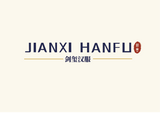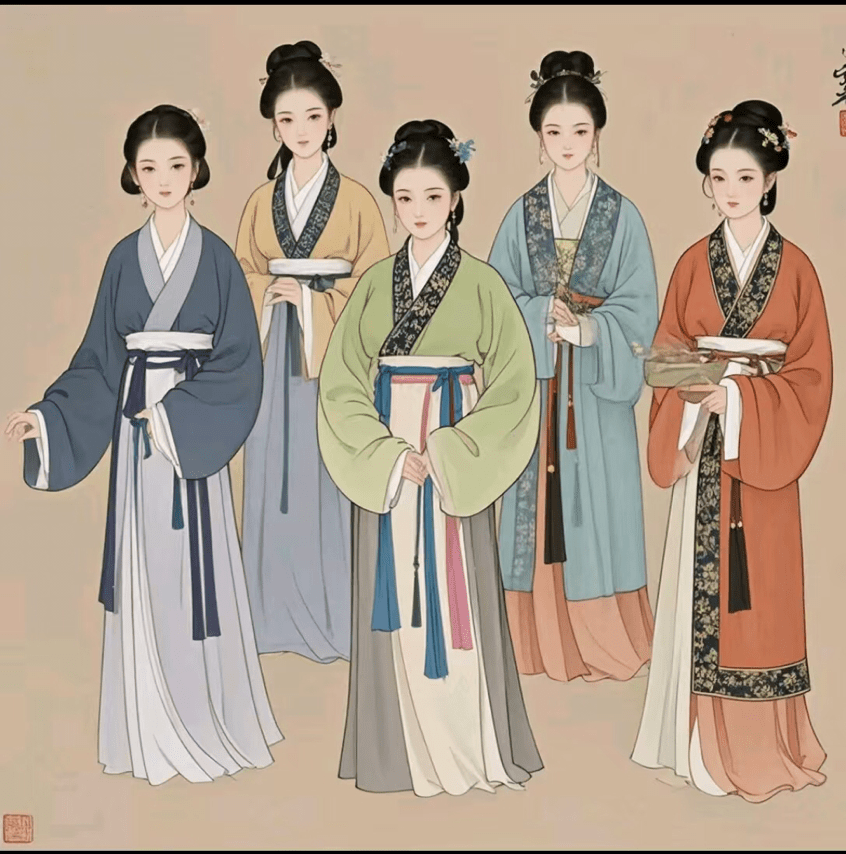The Mamian skirt/Horse face skirt, originally a "split-skirt,"
Has evolved through several dynasties - it was originally worn by women riding donkeys in the Song Dynasty. In the Song Dynasty, social life was varied and women travelled relatively frequently. Thus, the swirl skirt, useful when riding, became practical when women went out, and it reached its peak in the Ming Dynasty, becoming a common lower garment for men and women. Since the skirt border was very important in the capital city, people all wore the Horse-face skirt. The society was relatively rich and stable in the Ming Dynasty, and clothing culture developed greatly as well. During this period, both the style and production methods of horse-face skirts were generally perfected, and it became a popular dressing choice in prosperous areas such as the capital city during the Qing Dynasty. The Manche and Han cultures blended together during the Qing Dynasty while preserving their individual characteristics. Still, Han women preferred wearing the horse-face skirt. However, according to the general aesthetic of the time, it gradually became more elaborate with embroidery, edging, and other ornaments - in the early years of the Republic of China, the Horse-face skirt remained in the Qing Dynasty style but was simplified somewhat. Later, with the development of the times, the Horse-face skirt was collected in museums. And now it has entered people's vision again because of Hanfu. The society was undergoing a transition between the old and the new, and traditional clothing also began to simplify, early in the Republic of China. More modern clothing followed, and the Horse-face skirt was eventually dropped from daily wear and collected as a cultural heritage. But in recent years, due to the revival of interest in traditional culture and the Hanfu boom, the horse-face skirt has once again caught public attention and is often worn again.
The Horse-face Skirt originally was called a Horse-face because it resembled a horse's face on the city wall.
It was later used to describe clothing. In the records of the Inner Court of the Ming Dynasty, written by Liu Ruoyu, a eunuch, the term "Horse-face pleats" was used for "Yisa." And this was the name of the Ming Dynasty's Horse-face skirt. Such special structures were built for defense and other purposes in ancient architecture. People spotted parts on clothing that were similar in shape and took this name; this was the beginning of the history of the Horse-face skirt in clothing.

Characteristics of the Horse-face skirt
It has four Skirt fronts at the front and back, two pairs overlapping each other, and a trapezoidal smooth surface in the middle. This unique structural design gives the skirt a regular and layered appearance. Its skirt fronts are offset against each other, and the trapezoidal smooth surface is simple and elegant - the sides are pleated. The skirt has various pleating designs. They were mostly loose pleats in the Ming Dynasty and fine pleats or fish-scale pleats in the Qing Dynasty. The pleats lend a three-dimensional feeling to the skirt and allow for walking and other activities. The changes in pleating styles among different dynasties also reflect the differences in aesthetic and production techniques at that time. They are mainly pattern patterns with good meanings and are complex at the bottom and simple at the top. Common patterns include flowers, auspicious beasts, and auspicious characters, etc. Embroidery and other techniques signify longing and blessings for a better life. Additionally, this top-down layout follows the traditional aesthetic concept, which gives the garment a stable yet lively aesthetic feeling - Elements such as the opening and closing of the clothing body, overlapping of the skirt fronts, the pleating structure, and the pattern decoration show the coexistence of mobility, concealment, decoration, and etiquette. The opening and closing method, for example, make the wearing convenient, the overlapping of the skirt fronts make the wearing dignified, the pleats make the activities convenient, and the pattern decoration indicates the status and good meanings. All in all, these make the Horse-face skirt a practical yet beautiful garment with cultural connotations.
Horse-face skirt production techniques
The cutting, sewing, ironing, and pleating processes of Horse-face skirts are described in Caoxian County, Shandong Province, and Haizhu District, Guangzhou City. There are many craftsmen of Caoxian County. They inherit traditional production techniques. So they choose suitable fabrics and then cut them to precise dimensions, then sew the parts together with great care and then iron them to make them smoother and more fitting. And finally, they pleat. Professional production teams also work in Haizhu District, Guangzhou City. On the basis of traditional techniques, they will add some regional character to the horse-face skirts produced. Traditional design and plate-making follow the basic Horse-face skirt forms of the Ming and Qing Dynasties and emphasize making the best of everything. Material selection will be made according to style and quality requirements. So for instance, silk represents magnificence while cotton and linen represent simplicity. When designing and plate-making, the traditional Horse-face skirt is strictly followed. By embroidering, each stitch gives the skirt an artistic charm of its own. The sewing must be precise so that the skirt stays firm and beautiful in the Guangfu area. Today, other cool-feeling and short-faced Horse-face skirts are also available. Cantonese embroidery is known for its variable stitching methods, even stitches, and the clever use of texture in stitches to show the texture of objects. These are vividly embroidered on the skirt fronts, making the Horse-face skirt particularly attractive. Today, with the passage of time and people's needs changing, cool-feeling fabrics are used to make horse-face skirts, making them suitable for hot weather. Also available are short horse face skirts, which are more fun and lively and suit different occasions and tastes.
A traditional combination of horse-faced skirts

Jiaoling short jacket: The jiaoling short jacket is one of the upper garments often worn by women in the Ming Dynasty. When paired with the horse-face skirt, it can show a dignified and elegant temperament. Its crossed collar design has a unique classical charm. The short style can appropriately highlight the body proportion of the wearer. There are usually exquisite embroideries or traditional patterns on the jacket, which complement the horse-face skirt well and create an overall style that is both primitive and elegant. When wearing a jiaoling short jacket paired with a horse-face skirt and walking in an antique garden, it seems that one can travel back to ancient times and feel the gentleness and dignity of women at that time.
Standing-collar double-breasted long gown: The standing-collar double-breasted long gown is one of the upper garments often worn by men in the Ming Dynasty. When paired with the horse-face skirt, it can show a refined and elegant temperament. The design of the standing collar looks neat and energetic. The opening and closing method of the double-breasted style is convenient for wearing and rich in a sense of layering. The length and width of the long gown make the overall look more elegant and free. Coupled with some hidden patterns or simple edging decorations, when paired with the horse-face skirt, it fully displays the demeanor of a refined scholar, as if it were a gentle and noble gentleman walking out of an ancient painting.

Biji: Biji is a kind of sleeveless and collarless double-breasted upper garment. When paired with the horse-face skirt, it can show a lively and cute temperament. Its style is relatively loose and comfortable, convenient for movement when worn, and can give people a casual and lively feeling. The colors of Biji are usually diverse and gorgeous, and there are also various embroidered patterns with profound meanings on it. When paired with the horse-face skirt, it can not only highlight the elegance of the horse-face skirt but also add some liveliness and playfulness to the whole outfit, which is very suitable for daily wear or when participating in some folk activities.
Hair bun: Twisting the hair into a bun and matching it with hairpins, swaying hair ornaments and other headdresses can show a classical and elegant temperament. There are various styles of hair buns, such as the common single spiral bun, double spiral bun, lily bun and so on. Different bun styles are paired with corresponding hairpin ornaments. Some are simple and plain, while others are magnificent and exquisite. When paired with the horse-face skirt, the whole person will emit a strong classical atmosphere from the hairstyle to the clothing, just like an elegant and charming lady in ancient times.

Twisted braids: Braiding the hair into twisted braids and matching them with hairbands, hair clips and other headdresses can show a lively and cute temperament. The twisted braids can be loosely braided and hang down on both shoulders, or coiled up and fixed on the top of the head or the back of the head and then decorated with colorful hairbands or delicate small hair clips. When paired with the horse-face skirt, it gives people a fresh and lively feeling like a girl next door. It is especially suitable for choosing such a hairstyle when wearing the horse-face skirt on relatively relaxed occasions.
The Horse-face Skirt carries historical memories and cultural genes.
Representing the Chinese nation's idea of conveying ideas through clothing and thrift, and is a carrier of intangible cultural heritage. With hundreds of years of development, every pleat and every pattern in the Horse-face skirt contain both the wisdom of the ancients and the social features of that day. It has seen dynasties change and cultures mix. It has promoted the integration of culture and tourism and opened up new ideas by wearing the Horse-face skirt. Hanfu rentals and ancient-style portrait shooting have been very popular. Often today, tourists are photographed in Horse-face skirts at tourist attractions.




